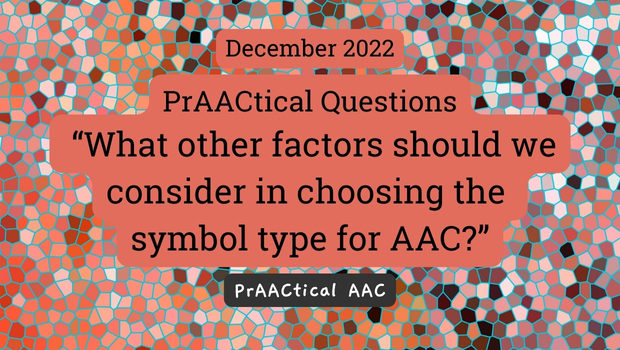PrAACtical Questions: “What other factors should we consider in choosing the symbol type for AAC?”

If you’ve been following along in our PrAACtical Questions series, you know that we’ve been contemplating the role that symbols play in AAC decision-making. Previously, we addressed:
- “How can we make data-based decisions about AAC symbols?”
- “How important is symbol selection in choosing AAC devices/apps?” and,
- “What symbols are used in AAC apps & SGDs?”
If you’ve followed this series, you know that we’ve advocated an individualized approach to determining which type of symbol to use for AAC. Informal assessment tasks, such as the ones we discussed in a past post, can be helpful in gathering data to use in making this decision.
Today, we’re exploring additional factors to consider in symbol selection. When there doesn’t seem to be a clear preference and/or when the performance is similar across symbol types, we turn to some other factors that are worth considering as you make your selection.
AAC User Perspective
A good starting point is to find out if it matters to the person who needs AAC support. Do they have a preference for one type over the others? Is there a type of AAC symbol they would like to avoid using in their AAC tools? Honoring their perspective on this is a top priority.
Symbols in the Environment
It’s worth finding out what types of symbols are already being used in visual supports and AAC in the classroom and at home. If they see those symbols every day, there may be an advantage in using them for AAC.
Symbol Availability
Not all symbol types are equally accessible. Consider whether there would be any additional costs to professionals and families for access to the symbols, since both may need to use them to create visual supports or AAC learning materials.
Diversity and Representation
Some types of symbols are better able to reflect diverse options that may be important to some communicators. In single-meaning pictures, it is helpful to have options regarding different skin tones, hairstyles, body types, ages, and other personal characteristics.
Did we miss any factors that you consider in making this decision? We’d love to hear about them.
Filed under: Featured Posts, PrAACtical Thinking
This post was written by Carole Zangari
